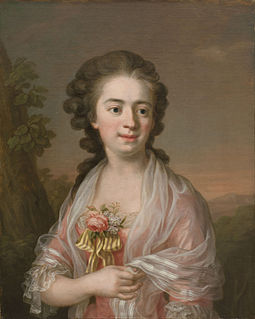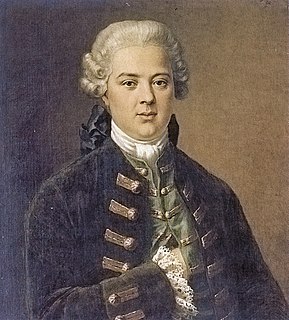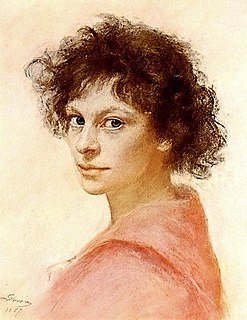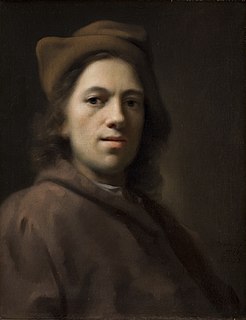
Johann Heinrich Bleuler, the Elder was a Swiss artist who worked with porcelain, landscape sketches and gouache. He was also an art teacher and a publisher of engravings.

Anton Graff was an eminent Swiss portrait artist. Among his famous subjects were Friedrich Schiller, Christoph Willibald Gluck, Heinrich von Kleist, Frederick the Great, Friederike Sophie Seyler, Johann Gottfried Herder, Gotthold Ephraim Lessing, Moses Mendelssohn and Christian Felix Weisse. His pupils included Emma Körner, Philipp Otto Runge and Karl Ludwig Kaaz.

Johann Michael Ferdinand Heinrich Hofmann was a German painter of the late 19th to early 20th century. He was the uncle of the German painter Ludwig von Hofmann. He was born in Darmstadt and died in Dresden. He is best known for his many paintings depicting the life of Jesus Christ.

Ulrika "Ulla" Fredrica Pasch, was a Swedish rococo painter and miniaturist, and a member of the Royal Swedish Academy of Arts.

Therese Maron, née Mengs, was a German (Saxonian) painter, for most of her life active in Rome. She was the elder sister of more known painter Anton Raphael Mengs.

The Hanseaten is a collective term for the hierarchy group consisting of elite individuals and families of prestigious rank who constituted the ruling class of the free imperial city of Hamburg, conjointly with the equal First Families of the free imperial cities Bremen and Lübeck. The members of these First Families were the persons in possession of hereditary grand burghership of these cities, including the mayors, the senators, joint diplomats and the senior pastors. Hanseaten refers specifically to the ruling families of Hamburg, Lübeck and Bremen, but more broadly, this group is also referred to as patricians along with similar social groups elsewhere in continental Europe.

Emma Sophie Körner was a German painter, a pupil of the Swiss painter Anton Graff, and sister of the poet and soldier Carl Theodor Körner.

Friedrich Carl Gröger was a north-German portrait painter and lithographer. One of the most respected portraitists of his time in northern Germany, his works are to be found in several museums, including the Hamburger Kunsthalle, as well as in north German, Holstein and Danish private collections.
Heineken is a patronymic surname meaning "son of little Hein" (Henry). Notable people with the surname include:

Heinrich Knirr was an Austrian-born German painter, known for genre scenes and portraits, although he also did landscapes and still-lifes. He is best-known for creating the official portrait of Adolf Hitler and is the only artist known to have painted Hitler from life.

Johann Heinrich Ferdinand Olivier (1785–1841) was a German painter associated with the Nazarene movement.

Heinrich Eduard Linde-Walther, born Walther Heinrich Eduard Linde was a German painter and illustrator.

Hermann Linde was a German painter in the Symbolist style. He specialized in "Oriental" themes.

Maria Slavona, born Marie Dorette Caroline Schorer was a German impressionist painter.

Vittoria Candida Rosa Caldoni was the most popular model among the German artists residing in Rome in the early nineteenth-century; especially those associated with the Nazarene movement. Over 100 paintings with her image have survived.

Friedrich Wilhelm Weidemann or Wiedemann was a German painter. From 1702 he worked as court painter to Frederick William I, prince and later king of Prussia. He also produced portraits of several other members of the Prussian royal family

Louise von Panhuys née von Barckhaus of Wiesenhütten was a German botanical artist and landscape painter.





















